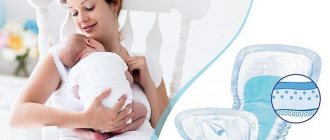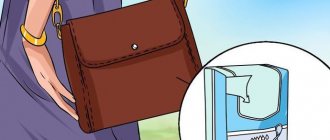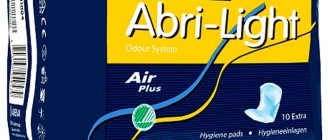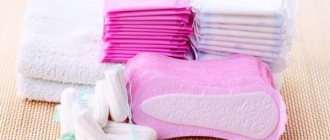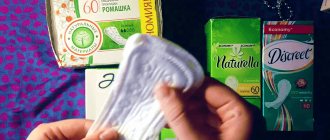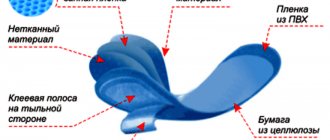If you run out of sanitary products at the wrong time, or are tired of buying them, you can sew reusable pads yourself . You need to choose fabric:
- natural “breathable”, for example, flannel, cotton and others;
- chintz or corduroy;
- something for a waterproof layer, such as cellophane;
- fabric or material for intensive absorption of menstrual flow, for example, many layers of gauze, cotton wool, flannel or microfiber.
In the same sequence, the materials should be placed on top of each other and stitched. After use, first of all, you need to wash such products in a solution with hydrogen peroxide, you can soak them, and then put them through regular washing.
You can even replace these hygiene products for a few hours with improvised materials:
- Take toilet paper and wrap it in many, many layers. You can twist it and place it in the perineum area, pressing it tightly to the labia.
- Use part of the towel, sheets and even a handkerchief.
- Place a plastic bag on the gusset of the panties (to prevent leaks), and gauze or cotton wool on top.
- Wrap the cotton wool with gauze.
What to replace if your period started suddenly at school:
- All options for “home remedies” are also suitable here.
- Don’t be shy to ask a friend or a couple of other classmates.
- You can contact a nurse. At least she will definitely have cotton wool and a bandage.
- There is no need to be afraid to call your mother or grandmother; perhaps someone will be free at this time and will help correct the situation.
- If a bloody stain suddenly appears on your clothes, you should try to hide it - tie a jacket or scarf around your waist and, if necessary, ask to go home or change into a change of clothes.
When sending a teenage girl to camp , a mother or other loved one should make sure that she has pads in case she gets her period for the first time.
If you still forgot about this, you can use all the methods that were described earlier. You should definitely notify the camp nurse about this. If the first menstruation is very heavy or painful, there is no need to hide it under any circumstances. Some complications may have developed and medical attention is required. You should notify your counselor or nurse about this. Girlfriends from the room can also help tell you.
You can use both pads and tampons (it is better to use the smallest ones with an applicator). For the first time, you should give preference to conventional gaskets.
Swimming in a pool, sea or lake is only possible when using tampons. In this case, you need to replace the hygiene product immediately after leaving the water, so as not to provoke various complications. If the girl is not yet ready for them, she will have to wait until her period ends.
Alternatives to conventional hygiene products:
- Menstrual panties are special reusable products made of an absorbent layer in the gusset area.
- Menstrual cups (mouth guards) are “cups”, containers made of polyethylene (in this case they are disposable) or latex (in this case they are reusable).
Menstrual cup
How to avoid incidents in the future:
- Keep a menstrual calendar even if your periods are regular.
- If you are expecting your period soon, it is helpful to use panty liners.
- You should listen to your body - on the eve of menstruation, many people note nagging pain in the lower abdomen, swelling of the mammary glands and other signs.
- During critical days, preference should be given to dark clothing.
- It’s a good idea to always have a couple of spare hygiene products with you in your purse.
Read more in our article about what to do if you don’t have pads and your period starts.
We sew a reusable version ourselves
There are situations in life when it is not possible to purchase ordinary hygiene products for “these days.” In this case, it is useful to know how to sew reusable pads yourself. To do this, you should purchase or look for the following fabric options at home:
- natural “breathable”, for example, flannel, cotton and others;
- chintz or corduroy;
- something for a waterproof layer, such as cellophane;
- fabric or material for intensive absorption of menstrual flow, for example, many layers of gauze, cotton wool, flannel or microfiber.
Next, in the same sequence, the materials should be placed on top of each other and stitched. After use, first of all, you need to wash such products in a solution with hydrogen peroxide, you can soak them, and then put them through regular washing.
Difference between urological and conventional pads
The main mistake of most patients suffering from uncontrolled bladder emptying is the use of conventional pads for menstrual periods.
Compared to urine, menstrual discharge has a more viscous consistency and smaller volume, so the hygiene products intended for it differ not only in shape, but also in the composition of the absorbent layers.
Women who use them during incontinence note the rapid development of an unpleasant odor, the formation of lumps and frequent leaks.
Unlike conventional pads, urological hygiene products:
- instantly absorb the released liquid over the entire surface;
- have a top layer with antiseptic impregnation, which prevents the growth of bacteria and the appearance of an unpleasant odor;
- have an anatomical shape that is preserved even when very wet;
- equipped with additional protective elements against leakage (corrugated sides, elastic bands and cuffs);
- designed for less frequent changes (if the product is correctly selected according to the amount of liquid absorbed, the pad can be used for 4-7 hours).
DETAILS: Lod therapy in urology
What to do if there are no gaskets at home
Even experienced women sometimes experience menstruation at the most inopportune moment, when there are no pads or tampons at home. You can even replace these hygiene products with improvised materials for a few hours. For example, you can use the following:
- Take toilet paper and wrap it in many, many layers. You can twist it and place it in the perineum area, pressing it tightly to the labia.
- You can use part of a towel, sheets, and even a handkerchief in exactly the same way.
- Another option is to put a plastic bag on the gusset of the panties (to prevent leaks), and gauze or cotton wool on top.
- You will get something like a gasket if you wrap the cotton wool with gauze.
Using these methods, you can easily get to the first kiosk or store and buy ready-made hygiene products.
We recommend reading about the types of gaskets. From the article you will learn about what a pad should be, types of urological and medical pads, alternatives to pads (menstrual cups and panties).
And here is more information about the rules of hygiene during menstruation.
Types of urological pads
All feminine hygiene products used in urology are divided into several types:
- By volume of absorbed liquid, depending on the degree of incontinence: up to 50 ml (drip form of incontinence);
- up to 100 ml (mild);
- up to 200 ml (medium level);
- up to 400-500 ml (severe urological disorders, enuresis).
- without additional protection (pads for drip incontinence);
- with a special absorbent layer;
What to replace if your period starts suddenly at school
Girls who have recently experienced menstruation are more likely to get into trouble than others. For example, your period may start at school at the most inopportune moment. In such cases, you should always have at least one or two pads or tampons in your purse. Then you don't have to worry about days like these. But you can find a way out of any situation. For example, for some time, gaskets can be replaced with the following options:
- All options for “home remedies” are also suitable here.
- There is no need to be embarrassed to ask a friend or a couple of other classmates; perhaps someone has already learned and always carries a spare pad with them.
- You can contact a nurse. At the very least, she will definitely have cotton wool and a bandage, and she may not be allowed out of physical education or even a lesson.
- There is no need to be afraid to call your mother or grandmother; perhaps someone will be free at this time and will help correct the situation.
- If a bloody stain suddenly appears on your clothes, you should try to hide it - tie a jacket or scarf around your waist and, if necessary, ask to go home or change into a change of clothes.
Reusable (cloth) pads
This is the perfect solution for those who don't know how to insert a menstrual cup, but really want to take care of the planet even during their period. A reusable pad is not a diaper or a rag at all, as in the USSR, but a modern and high-tech product.
What are reusable pads made of?
Mostly, reusable pads are made from cotton and fleece; some have a special membrane fabric inside. It does not allow moisture to pass through, but it “breathes” perfectly, due to which the pad does not float, absorbs well and is not visible under clothing.
There are both panty liners and thick pads for heavy flow.
instagram.com/mavka.be.eco
How to use cloth pads
It's simple: just like usual. They are attached to the laundry using buttons, and after use they are rolled up into an envelope, placed in a special bag and put away until washed. They don't smell because the secretions dry out.
Afterwards, you simply wash the pads and dry them, and then you can use them again.
Benefits of reusable pads
- Comfortable to wear and use. Cloth pads are much nicer to the body than disposable ones. They are made from natural materials, and there are several layers of fabric inside, so the pads breathe, do not leak liquid and are usually very soft.
- No smell. Menstrual fluid dries out rather than accumulates, so you end up with an odorless stain on the fabric.
- No greenhouse effect. A regular pad does not “breathe”, so a greenhouse effect occurs and creates a breeding ground for bacteria to multiply. Just imagine: this horror comes into contact with the mucous membrane of the genital organs and bacteria can even spread throughout the body. Horrible! But the fabric lining breathes well, so there will be no such effect.
- Eco-friendly. Reusable pads are not made from plastic or petroleum products, and to ensure sterility they are also disinfected before sale. Not only are they good for your mucous membranes, but they will also last up to five years and can be safely disposed of after use.
- Economical. Cloth pads are more expensive than regular pads, but they pay for themselves very well, because you don’t have to buy a new pack every month! You will save a lot and can spend the money on something more useful.
It turns out that there are many much more convenient ways to manage during menstruation. So don't be afraid to experiment.
Read also:
Fitness, no matter how you look at it, or How to exercise even these days!
First menstruation in camp
Expert opinion
Daria Shirochina (obstetrician-gynecologist)
When sending a teenage girl to camp, a mother or other loved one should make sure that she has pads in case she gets her period for the first time, because you can never tell when this will happen.
If you still forgot about this, you can use all the methods that were described earlier. You should definitely notify the nurse at the camp about this, maybe she can help with something. If the first menstruation is very heavy or painful, there is no need to hide it under any circumstances. Perhaps some complications have developed and medical attention is required.
You should notify your counselor or nurse about this. Girlfriends from the room can also help tell you if the girl herself is embarrassed to talk about it.
How to properly use a tampon with an applicator
You can use both pads and tampons (it is better to use the smallest ones with an applicator). But perhaps for the first time you should give preference to ordinary gaskets in order to be sure to understand what is happening.
It should be remembered that swimming in a pool, sea or lake is only possible when using tampons. In this case, you need to replace the hygiene product immediately after leaving the water, so as not to provoke various complications. If the girl is not yet ready for them, then she will have to wait until her period ends.
Watch this video about how you can replace a pad during your period:
How to make gaskets yourself?
If the list of advantages has inspired you to create your own fabric pads, then it’s time to get to work. The principle of their creation is extremely simple! If you have some flannel fabric and a good skill with a sewing machine (they can also be sewn by hand), then it will not be difficult for you to sew a simple fabric pad.
Tools and materials
- Flannel: not very much, about 23 cm (the original suggests using ¼ yard), preferably in two different colors;
- Sewing machine;
- A thread;
- Measuring tape;
- Scissors.
Progress
- You need to print the template in full size and transfer its outline to the fabric from the wrong side. To do this, you can use a pen or a fabric pencil, or whatever you have on hand.
- Cut out two blanks of each part.
- Turn the fabric inside out and sew the interfacing around the edges. Stitch carefully, leaving no gaps. Do the same for the wing gaskets.
- Cut a hole on one side of the wings.
- Next, you need to turn the fabric right side out. Do this for the wings and the pad itself, then iron the fabric.
- All that remains is to sew both sides to see the finished gasket.
- Don't forget to stitch the edges of the wings.
- For convenience, you can attach Velcro or a button to the wings of the gasket. Otherwise, you will have to look for alternative ways to secure it to your underwear during use.
That's all! It takes about 20 minutes to create such a gasket.
Gasket template
Link to PDF file
Some tips for making and further caring for the gasket
- The cheaper the flannel you buy for sewing, the shorter the life of the gasket. In this case, it is better to spend money on higher quality fabric in order to ultimately get more benefits from its use. Make sure your flannel is made from 100% cotton. Artificial fabrics can create a greenhouse effect.
- Before you start sewing, be sure to wash the fabric to avoid shrinkage of the finished product.
- To make the pads last longer, wash them immediately after use. First, wash or soak them in cold water, and then wash them along with your underwear. It is important not to use scented laundry detergent when washing, as it can cause skin irritation.
Share in the comments, did you manage to sew fabric pads yourself? It is also interesting to know the opinion of girls who are already using such eco-alternatives to conventional pads.
Found any inaccuracies in the translation? Do some phrases seem incomprehensible even to an experienced needlewoman? Be sure to write to us about this in the comments, and we will edit and improve the article as soon as possible.
The text was translated and adapted from English by the editor-in-chief of the site “Rukodelnik.Su” - Daria Kartokhina. The original master class with illustrations is available at the link - https://www.littlehouseliving.com
Alternatives to conventional hygiene products
In addition to the well-known pads and tampons, there are other alternative hygiene products on such days. For example, the list could be represented as follows:
- Menstrual panties are special reusable products made of an absorbent layer in the gusset area. Manufacturers claim that you can forget about leaks and other troubles “these days” if you use such products regularly. The easiest way to purchase them is in online stores. However, many girls, having used menstrual panties, write unflattering reviews about them.
Menstrual panties
- Menstrual cups (mouth guards) are “cups”, containers made of polyethylene (in this case they are disposable) or latex (in this case they are reusable). In appearance, it resembles a small bell with a tail, by pulling on which you can remove the product from the vagina. Menstrual cups come in different sizes, which must be selected based on the volume of discharge and the distensibility of the vagina.
Installing the mouthguard is easy, similar to inserting a tampon. Inside, they “stick” due to negative pressure to the walls of the vagina, so all the discharge gets into it and not past it. Menstrual cups last for years, making them one of the most cost-effective options.
Watch this video on how to properly use a menstrual cup:
How to choose urological pads for women
Up to 40% of the fairer sex, regardless of age, encounter various forms of urinary incontinence. Most often, the causes of the problem are various hormonal disorders, menopause and increased load on the pelvic organs during pregnancy and childbirth.
Usually the disorder is temporary and can be successfully treated with therapeutic correction, but it causes significant discomfort to patients. The use of special hygiene products designed to retain excreted urine helps improve the quality of life. Let's consider how to choose urological pads for women; a comparison table of the most popular products.
How to avoid incidents in the future
To ensure that your period doesn’t seem like a surprise, it is recommended to use the following tips:
- You should keep a menstrual calendar even if a woman has regular periods.
- If you're expecting your period soon, it's a good idea to use pantyliners in case they start unexpectedly.
- You should listen to your body - on the eve of menstruation, many people note nagging pain in the lower abdomen, swelling of the mammary glands and other signs.
- During critical days, you should give preference to dark clothes; stains from discharge are not so noticeable on them.
- It is useful to always have a couple of spare hygiene products with you in your purse in case of an unexpected onset of your period.
We recommend reading about how to use tampons. From the article you will learn about who should use tampons and when, and the correct insertion of a tampon with and without an applicator.
And here is more information about the benefits and harms of using Chinese tampons.
Pads and tampons are modern hygiene products. Our grandmothers still remember the time when no one knew about them and there was no discomfort from it. In every situation, you can find a way out, even if your period started for the first time or just unexpectedly in the wrong place.
Causes of spotting
There are many factors that influence the amount of discharge during menstruation. Let's take a closer look at some of the reasons why spotting may occur.
Woman's age
During puberty in adolescence, the monthly cycle is irregular, and failures in ovulation may occur. That is why spotting is the norm for 1–2 years after menarche, and is not considered a deviation from the norm, since during this period the formation of menstrual function occurs. If this period has been prolonged and spotting is observed more than two years after the onset of menarche, then this is a good reason to seek advice from a specialist.
https://youtu.be/MUoGPBnrsfQ
In the period before menopause (from the age of forty years), spotting may also be observed, which indicates a decrease in hormonal levels in a woman and a natural decline in the reproductive function of the reproductive system during menopause.
Pregnancy
In the early stages, spotting may be observed, which indicates embryo implantation. Therefore, to confirm the “interesting situation,” we advise you to take a pregnancy test and check the level of hCG in the blood.
If pregnancy is confirmed by a hCG test or analysis, and scanty periods continue for a long time, this may be an alarming sign indicating a hormonal disorder and an incipient miscarriage. Your body may not have enough hormones that are necessary to support the embryo. To avoid miscarriage, contact your gynecologist immediately.
Ectopic pregnancy
Abnormal placement of the embryo can lead to spotting brown discharge. Pathological pregnancy occurs when the fertilized egg develops outside the uterus. For example, in the fallopian tube or cervix. The pregnancy test in this case shows a positive result. Your gynecologist may prescribe an ultrasound to determine where the fertilized egg is implanted.
Inflammatory and hormonal diseases
Inflammatory diseases of the female reproductive organs can cause disruption of the menstrual cycle. Inflammation can occur due to hypothermia of the body.
